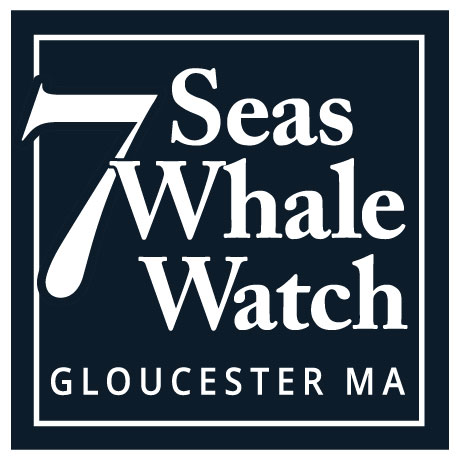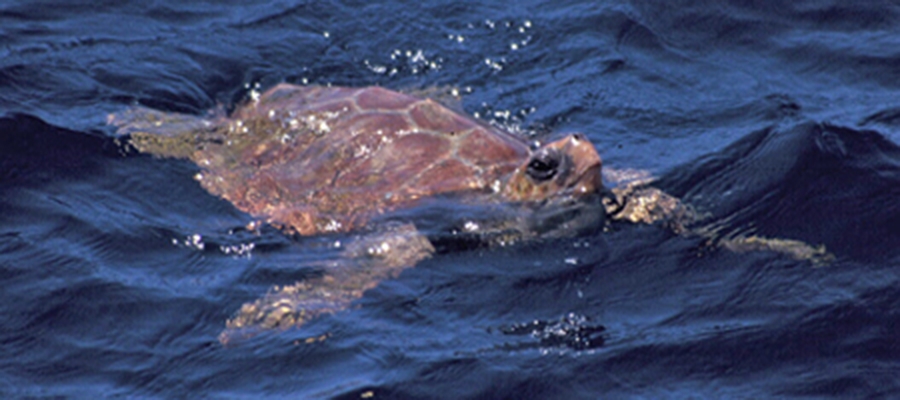Sea Turtles
While the whales are, of course, always the main focus of our trips, there are a lot of other interesting wildlife species that we sometimes encounter while out on the ocean. On this page, you can learn a little bit about the different species of Sea turtles that we have seen off the coast of Gloucester, MA.
Sea turtles are rare in the waters off the coast of New England. We have only seen them a handful of times on one of our whale watches, but awareness of these animals and of their presence in our area is important because most species of Sea turtles are critically endangered. There are many reasons that sea turtles are endangered and they include: habitat destruction, motor vehicle traffic on beaches where the lay eggs, light pollution which confuses newly hatched turtles that have evolved to follow the light of the moon to water, entanglement in fishing gear, marine pollution (especially balloons which look like jellyfish to a turtle), and even the harvesting of their shells for the making of combs, guitar or mandolin picks, and other items that could easily be made out of other substances that are not derived from endangered species. So as you might imagine the challenges facing those who want to help sea turtles are many, but it all starts with awareness. That’s what this page is for.
So on to the species, you could see in New England waters:
LEATHERBACK SEA TURTLE
The Leatherback Sea turtle is probably the most abundant species or Sea turtle in our area, but they are by no means common. In the 24 years, I have been working with 7 Seas Whale Watch I have only seen one twice (three times if you include a sighting of a deceased individual on Jeffrey’s Ledge).
Leatherback got their name for the leathery, gray-green skin which covers their backs in place the usually hard shell (or “carapace”) found in other Sea Turtle species. They are the largest (extant) turtle on the planet, with adults commonly reaching lengths of six feet or more and weighing over 1,000 pounds! Their average lifespan in the wild is about 45 years.
In general, Sea turtles are tropical, warm-water animals that only rarely venture into cooler, temperate waters like those of Massachusetts Bay and the rest of the Gulf of Maine. The Leatherback is therefore highly unusual in that it can be found as far north Labrador in eastern Canada! This species’ ability to withstand cold water means that it is possible to see a Leatherback at any time during the late spring through the early fall months in our area.
LOGGERHEAD SEA TURTLE
The only other species of Sea Turtle I have seen during one of our whale watching trips (and the only one I have managed a photograph of!) is the Loggerhead sea turtle. They have a reddish-brown carapace (top shell) and a yellow plastron (lower shell). The name “Loggerhead” comes from its disproportionally large head.
The typical adult Loggerhead is between 2 and 3 feet long and weighs about 300 pounds. They have a known lifespan of at least 70 years.
Like nearly all Sea turtles, the Loggerhead’s diet consists mainly of jellyfish, so whenever large numbers of Sea gooseberries, Moon jellies, or any of the other myriad of Cnidarians that can be found in our waters happen to be particularly abundant it would be wise to keep an eye out for Loggerhead and other sea turtles.
OTHER SEA TURTLES WE
In addition to the Leatherback and Loggerhead, there are three other sea turtle species that can be found in our waters: The KEMP’S RIDLEY, the HAWKSBILL, and GREEN SEA TURTLES. I have never seen any of these species on one of our whale watches and so I am not going to go into great detail about them here as I want to limit the discussion to things we have actually seen. However, as you might have surmised if you’ve read to this point, sea turtles and awareness of the conservation issues associated with them is an important issue to me and so I wanted to at least mention that these endangered animals are present here, even if only rarely and in small numbers.
I hope to someday get to see one of these other turtle species while out on one of our whale watching trips, and if I do you can be sure that I will add more information (and hopefully photos) to this page! Until then, please explore the internet and other resources for information about these fascinating creatures and please do what you can to help make sure that we still can hold out hope that one day we’ll see one.


